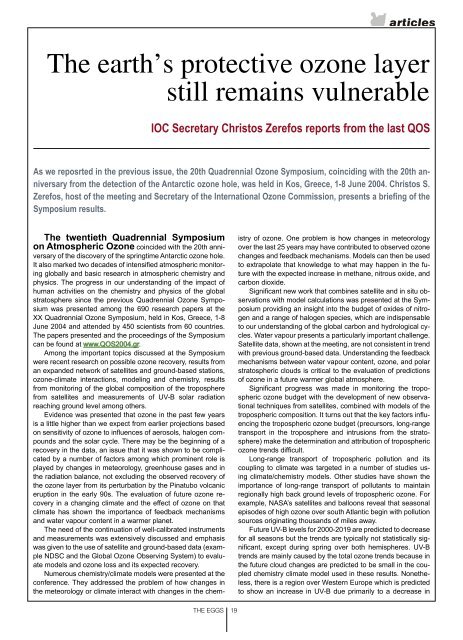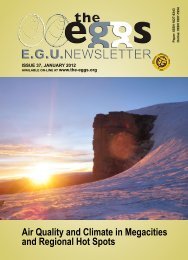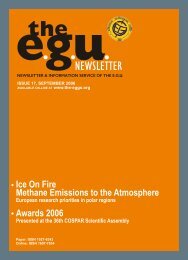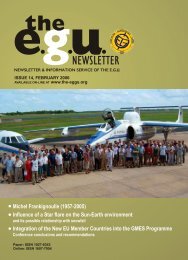Report on the Berlin 2 Open Access Conference - European ...
Report on the Berlin 2 Open Access Conference - European ...
Report on the Berlin 2 Open Access Conference - European ...
Create successful ePaper yourself
Turn your PDF publications into a flip-book with our unique Google optimized e-Paper software.
The earth’s protective oz<strong>on</strong>e layerstill remains vulnerableIOC Secretary Christos Zerefos reports from <strong>the</strong> last QOSAs we reposrted in <strong>the</strong> previous issue, <strong>the</strong> 20th Quadrennial Oz<strong>on</strong>e Symposium, coinciding with <strong>the</strong> 20th anniversaryfrom <strong>the</strong> detecti<strong>on</strong> of <strong>the</strong> Antarctic oz<strong>on</strong>e hole, was held in Kos, Greece, 1-8 June 2004. Christos S.Zerefos, host of <strong>the</strong> meeting and Secretary of <strong>the</strong> Internati<strong>on</strong>al Oz<strong>on</strong>e Commissi<strong>on</strong>, presents a briefing of <strong>the</strong>Symposium results.The twentieth Quadrennial Symposium<strong>on</strong> Atmospheric Oz<strong>on</strong>e coincided with <strong>the</strong> 20th anniversaryof <strong>the</strong> discovery of <strong>the</strong> springtime Antarctic oz<strong>on</strong>e hole.It also marked two decades of intensified atmospheric m<strong>on</strong>itoringglobally and basic research in atmospheric chemistry andphysics. The progress in our understanding of <strong>the</strong> impact ofhuman activities <strong>on</strong> <strong>the</strong> chemistry and physics of <strong>the</strong> globalstratosphere since <strong>the</strong> previous Quadrennial Oz<strong>on</strong>e Symposiumwas presented am<strong>on</strong>g <strong>the</strong> 690 research papers at <strong>the</strong>XX Quadrennial Oz<strong>on</strong>e Symposium, held in Kos, Greece, 1-8June 2004 and attended by 450 scientists from 60 countries.The papers presented and <strong>the</strong> proceedings of <strong>the</strong> Symposiumcan be found at www.QOS2004.gr.Am<strong>on</strong>g <strong>the</strong> important topics discussed at <strong>the</strong> Symposiumwere recent research <strong>on</strong> possible oz<strong>on</strong>e recovery, results froman expanded network of satellites and ground-based stati<strong>on</strong>s,oz<strong>on</strong>e-climate interacti<strong>on</strong>s, modeling and chemistry, resultsfrom m<strong>on</strong>itoring of <strong>the</strong> global compositi<strong>on</strong> of <strong>the</strong> tropospherefrom satellites and measurements of UV-B solar radiati<strong>on</strong>reaching ground level am<strong>on</strong>g o<strong>the</strong>rs.Evidence was presented that oz<strong>on</strong>e in <strong>the</strong> past few yearsis a little higher than we expect from earlier projecti<strong>on</strong>s based<strong>on</strong> sensitivity of oz<strong>on</strong>e to influences of aerosols, halogen compoundsand <strong>the</strong> solar cycle. There may be <strong>the</strong> beginning of arecovery in <strong>the</strong> data, an issue that it was shown to be complicatedby a number of factors am<strong>on</strong>g which prominent role isplayed by changes in meteorology, greenhouse gases and in<strong>the</strong> radiati<strong>on</strong> balance, not excluding <strong>the</strong> observed recovery of<strong>the</strong> oz<strong>on</strong>e layer from its perturbati<strong>on</strong> by <strong>the</strong> Pinatubo volcanicerupti<strong>on</strong> in <strong>the</strong> early 90s. The evaluati<strong>on</strong> of future oz<strong>on</strong>e recoveryin a changing climate and <strong>the</strong> effect of oz<strong>on</strong>e <strong>on</strong> thatclimate has shown <strong>the</strong> importance of feedback mechanismsand water vapour c<strong>on</strong>tent in a warmer planet.The need of <strong>the</strong> c<strong>on</strong>tinuati<strong>on</strong> of well-calibrated instrumentsand measurements was extensively discussed and emphasiswas given to <strong>the</strong> use of satellite and ground-based data (exampleNDSC and <strong>the</strong> Global Oz<strong>on</strong>e Observing System) to evaluatemodels and oz<strong>on</strong>e loss and its expected recovery.Numerous chemistry/climate models were presented at <strong>the</strong>c<strong>on</strong>ference. They addressed <strong>the</strong> problem of how changes in<strong>the</strong> meteorology or climate interact with changes in <strong>the</strong> chemistryof oz<strong>on</strong>e. One problem is how changes in meteorologyover <strong>the</strong> last 25 years may have c<strong>on</strong>tributed to observed oz<strong>on</strong>echanges and feedback mechanisms. Models can <strong>the</strong>n be usedto extrapolate that knowledge to what may happen in <strong>the</strong> futurewith <strong>the</strong> expected increase in methane, nitrous oxide, andcarb<strong>on</strong> dioxide.Significant new work that combines satellite and in situ observati<strong>on</strong>swith model calculati<strong>on</strong>s was presented at <strong>the</strong> Symposiumproviding an insight into <strong>the</strong> budget of oxides of nitrogenand a range of halogen species, which are indispensableto our understanding of <strong>the</strong> global carb<strong>on</strong> and hydrological cycles.Water vapour presents a particularly important challenge.Satellite data, shown at <strong>the</strong> meeting, are not c<strong>on</strong>sistent in trendwith previous ground-based data. Understanding <strong>the</strong> feedbackmechanisms between water vapour c<strong>on</strong>tent, oz<strong>on</strong>e, and polarstratospheric clouds is critical to <strong>the</strong> evaluati<strong>on</strong> of predicti<strong>on</strong>sof oz<strong>on</strong>e in a future warmer global atmosphere.Significant progress was made in m<strong>on</strong>itoring <strong>the</strong> troposphericoz<strong>on</strong>e budget with <strong>the</strong> development of new observati<strong>on</strong>altechniques from satellites, combined with models of <strong>the</strong>tropospheric compositi<strong>on</strong>. It turns out that <strong>the</strong> key factors influencing<strong>the</strong> tropospheric oz<strong>on</strong>e budget (precursors, l<strong>on</strong>g-rangetransport in <strong>the</strong> troposphere and intrusi<strong>on</strong>s from <strong>the</strong> stratosphere)make <strong>the</strong> determinati<strong>on</strong> and attributi<strong>on</strong> of troposphericoz<strong>on</strong>e trends difficult.L<strong>on</strong>g-range transport of tropospheric polluti<strong>on</strong> and itscoupling to climate was targeted in a number of studies usingclimate/chemistry models. O<strong>the</strong>r studies have shown <strong>the</strong>importance of l<strong>on</strong>g-range transport of pollutants to maintainregi<strong>on</strong>ally high back ground levels of tropospheric oz<strong>on</strong>e. Forexample, NASA’s satellites and ballo<strong>on</strong>s reveal that seas<strong>on</strong>alepisodes of high oz<strong>on</strong>e over south Atlantic begin with polluti<strong>on</strong>sources originating thousands of miles away.Future UV-B levels for 2000-2019 are predicted to decreasefor all seas<strong>on</strong>s but <strong>the</strong> trends are typically not statistically significant,except during spring over both hemispheres. UV-Btrends are mainly caused by <strong>the</strong> total oz<strong>on</strong>e trends because in<strong>the</strong> future cloud changes are predicted to be small in <strong>the</strong> coupledchemistry climate model used in <strong>the</strong>se results. N<strong>on</strong>e<strong>the</strong>less,<strong>the</strong>re is a regi<strong>on</strong> over Western Europe which is predictedto show an increase in UV-B due primarily to a decrease inTHE EGGS 19





